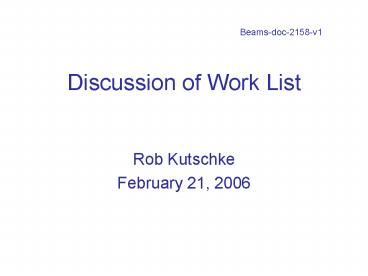Discussion of Work List PowerPoint PPT Presentation
1 / 6
Title: Discussion of Work List
1
Discussion of Work List
Beams-doc-2158-v1
- Rob Kutschke
- February 21, 2006
2
- Verify that all flash measurements are properly
timed in. Add or subtract delays of about 20
buckets to see if the intensity goes up and down
as expected. We can do this using the I44 bucket
delay. - From Bob sure, we've made a cursory check of
this but not completely systematic, should be a
quick manual check. - High priority are the flashes triggered by AA
markers at least roughly timed in. I have not
see this checked. Maybe it has been? - Low priority checking the BES trigger flashes is
really a double check. Nice if we can do a
systematic survey before shutdown but it should
not stop higher priority stuff.
3
- Verify that all combinations of the following
give the same position - closed orbit vs turn by turn
- 53 MHz vs 22 MHz
- proton vs pbar
- low/hi/medium gain
- I am not sure if we actually have states that
allow us to measure all 24 combinations but we
should do as many as possible. To do this we
need to get data from a variety of states in a
short period of time when the orbit is believed
not to have drifted. We should mix in some
closed orbit, 53 MHz, proton high gain
throughout the study in order to verify that the
orbit has remained stable. - Reply from Bob Rob identifies a very large
parameter space... - CO vs. TBT should
certainly be checked - as well as 53 vs. 2.5
(provided suitable beam can be had,
moderateintensity single batch beam will
probably work) - proton vs. pbar is probably a
very difficult comparison due to lack of
acredible reference between the two beams -
low/hi/med gain can be checked in the machine
with suitable beam, butone must be careful to
compare apples to apples. - High Priority
- CO vs TBT for one proton state and one pbar
state. - Identify at least one point of comparison between
p and pbar. - Identify one state in which we can do a
meaningful 53 vs 2.5 MHz comparison. - Low Priority
- Do the above on more than 1 state.
- Understand if there is a state that easily lets
us check the gain dependence.
4
- What can we do to test if position depends on
intensity? We already have the test using slow
spill. I am not sure what else we can easily
do. - From Bob position vs. intensity could be a
never-ending task, the position vs.time during
slow spill is a good milepost - Nothing more before shutdown.
- Scan the finest grained delays ( the Echotek
channel delays, denominated in ticks of the 10/7
clock. ) and verify that the measured position
does not change. This will change the behaviour
of any high frequency stuff that aliases into the
pass band of the digital filter. In the TeV we
did this test without doing any extra work
because of the 5 stable phases - we checked that
the position was the same for all phases. - From Bob yes, to get handle on size of effect
(although it might vary channel tochannel
depending on RF filter matching far out into the
"stop band"), butnot high priority as results
would be unlikely to change present design. - Medium Priority do it before shutdown if it does
not get in the way of other things. - Measure resolutions for as many combinations of
2) as possible. Check that they make sense. - From Bob yes, under well known and documented
conditions. Peter is awaitingopportunity to to
this for some TBT measurements. - High Priority Whatever get done in 2), make
sure to get resolutions too.
5
- Understand the offset issues that were raised at
the Tuesday meeting on Feb 14/06. - From Bob certainly and important before shutdown
- High Priority. Dave suggested there are some
sign errors? I am not sure who should work on
this. - Verify that the I44 pre-trigger delay works as
expected. - From Bob yes
- High Priority this is a small job. Just do it.
- Make turn-by-turn measurements at places where
the closed orbit resolution is poor and see what
frequencies contribute to the poor resolution.
Are these understood? - From Bob yes
- High Priority a quick survey is a small job. Do
that much before shutdown.
6
- Can we use the two existing houses to understand
timing between houses, to ensure that the "seam"
in the ring-wide turn by turn data is in the
right spot? - From Bob yes, but probably will only provide
partial answer for entire ultimatering-wide
system, not necessarily high priority before
shutdown - Low priority. No plans to do anything before
shutdown. This requires the mods to the timing
card to get this right.

